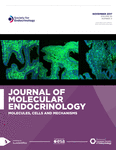Mechanisms of uterine estrogen signaling during early pregnancy in mice: an update
- 1Department of Obstetrics and Gynecology, University of Cincinnati, West Chester, Ohio, USA
- 2Division of Reproductive Sciences, Cincinnati Children’s Hospital Medical Center, Cincinnati, Ohio, USA
- 3Perinatal Institute, Cincinnati Children’s Hospital Medical Center, Cincinnati, Ohio, USA
- 4Department of Pediatrics, University of Cincinnati College of Medicine, Cincinnati, Ohio, USA
- Correspondence should be addressed to S K Das; E-mail: sanjoy.das{at}cchmc.org
Abstract
Adherence of an embryo to the uterus represents the most critical step of the reproductive process. Implantation is a synchronized event between the blastocyst and the uterine luminal epithelium, leading to structural and functional changes for further embryonic growth and development. The milieu comprising the complex process of implantation is mediated by estrogen through diverse but interdependent signaling pathways. Mouse models have demonstrated the relevance of the expression of estrogen-modulated paracrine factors to uterine receptivity and implantation window. More importantly, some factors seem to serve as molecular links between different estrogen pathways, promoting cell growth, acting as molecular chaperones, or amplifying estrogenic effects. Abnormal expression of these factors can lead to implantation failure and infertility. This review provides an overview of several well-characterized signaling pathways that elucidates the molecular cross talk involved in the uterus during early pregnancy.
- Received 6 February 2016
- Accepted 17 February 2016
- Made available online as an Accepted Preprint 1 April 2016
- © 2016 Society for Endocrinology











